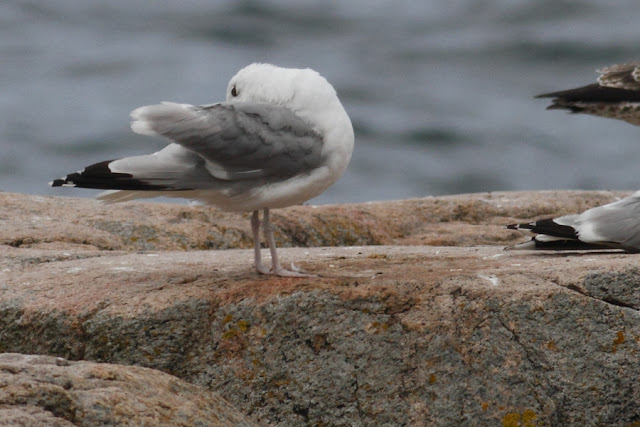The uniform brown 'sjawl' and the pattern of the tail-coverts; traces of brown and black in the wing coverts and tertials; distinct primary pattern with broad black band on P5 and white mirror on P10; and the tail band in this bird gave a smithsonianus impression.
3rd-cycle is a very tricky plumage and it is thus vital to look at the whole plumage with a critical eye. Details like the tail and secondary pattern are crucial, and unfortunately do not look typical for smithsonianus in this one.
 |
| Note that the dark in the tertials is blackish as in smitsonianus rather than brown as often is the case in typical Herring Gull |
 |
| The new (grey) mantle feathers are slightly paler than on the nearby argentatus which was also the impression when it was seen together with other adult and near-adult argentatus |
 |
| Densly dark-patterned hindneck, creating solid dark necklace |
 |
| Note extensive blackish-brown in tertials, only with vermiculation at the tip |
 |
| Barred undertail coverts. Thin barring on the tail coverts in a 3rd-cycle Herring Gulls indicate a northern origine such as Iceland |
 |
| The hindneck shows rather plain and smooth streaking (usually a lot of longitudinal streaking in typical argentatus) |
 |
| Scattered smudging across breast from nape ... |
 |
| ... and dark smudging on the belly |
 |
| New innner primaries strickingly paler than greater coverts as in smitsonianus and argenteus, but more rare in argentatus. Note also white mirror on P10 |
 |
| The secondaries are irregularly vermiculated brownish as in European Herring Gull and lack clean black as in smithsonianus |
 |
| Note discrete dark brown marks on secondaries. The greater coverts of 3rd winter smithsonianus are not usually this coarsely barred, and the same is true for the tertials |
 |
| Note that tail is still rather heavily marked, however, in smithsonianus the tail usually looks a bit more solid black than this |
 |
| Sooty tipped underwing coverts and white armpits |
 |
| Note that there are a few barred uppertail coverts |





































